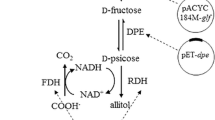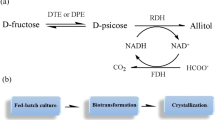Abstract
A whole-cell biotransformation system for the conversion of d-fructose to d-mannitol was developed in Escherichia coli by constructing a recombinant oxidation/reduction cycle. First, the mdh gene, encoding mannitol dehydrogenase of Leuconostoc pseudomesenteroides ATCC 12291 (MDH), was expressed, effecting strong catalytic activity of an NADH-dependent reduction of d-fructose to d-mannitol in cell extracts of the recombinant E. coli strain. By contrast whole cells of the strain were unable to produce d-mannitol from d-fructose. To provide a source of reduction equivalents needed for d-fructose reduction, the fdh gene from Mycobacterium vaccae N10 (FDH), encoding formate dehydrogenase, was functionally co-expressed. FDH generates the NADH used for d-fructose reduction by dehydrogenation of formate to carbon dioxide. These recombinant E. coli cells were able to form d-mannitol from d-fructose in a low but significant quantity (15 mM). The introduction of a further gene, encoding the glucose facilitator protein of Zymomonas mobilis (GLF), allowed the cells to efficiently take up d-fructose, without simultaneous phosphorylation. Resting cells of this E. coli strain (3 g cell dry weight/l) produced 216 mM d-mannitol in 17 h. Due to equimolar formation of sodium hydroxide during NAD+-dependent oxidation of sodium formate to carbon dioxide, the pH value of the buffered biotransformation system increased by one pH unit within 2 h. Biotransformations conducted under pH control by formic-acid addition yielded d-mannitol at a concentration of 362 mM within 8 h. The yield Y D-mannitol/D-fructosewas 84 mol%. These results show that the recombinant strain of E. coli can be utilized as an efficient biocatalyst for d-mannitol formation.




Similar content being viewed by others
References
Barnell WO, Yi KC, Conway T (1990) Sequence and genetic organization of a Zymomonas mobilis gene cluster that encodes several enzymes of glucose metabolism. J Bacteriol 172:7227–7240
Bradford MM (1976) A rapid and sensitive method for the quantitation of micrgram quantities of protein utilizing the principles of protein-dye binding. Anal Biochem 72:248–254
Bringer-Meyer S, Sahm H (1988) Acetoin and phenylacetylcarbinol formation by the pyruvate decarboxylases of Zymomonas mobilis and Saccharomyces carlsbergensis. Biocatalysis 1:321–331
Budesinsky Z, Protiva M (1961) Ephedrin. In: Knobloch W (ed) Synthetische Arzneimittel, Akademie-Verlag, Berlin, pp 24–27
Endo T, Koizumi S (2001) Microbial conversion with cofactor regeneration using genetically engineered bacteria. Adv Synth Catal 343:521–526
Galkin A, Kulakova L, Tishkov V, Esaki N, Soda K (1995) Cloning of formate dehydrogenase gene from a methanol-utilizing bacterium Mycobacterium vaccae N10. Appl Microbiol Biotechnol 44:479–483
Galkin A, Kulakova L, Yoshimura T, Soda K, Esaki N (1997) Synthesis of optically active amino acids from alpha-keto acids with Escherichia coli cells expressing heterologous genes. Appl Environ Microbiol 63:4651–4656
Hahn G, Kaup B, Bringer-Meyer S, Sahm H (2003) A zinc-containing mannitol-2-dehydrogenase from Leuconostoc pseudomesenteroides ATCC 12291: purification of the enzyme and cloning of the gene. Arch Microbiol 179:101–107
Haltrich D, Nidetzky B, Miemietz G, Gollhofer D, Lutz S, Stolz P, Kulbe KD (1996) Simultaneous enzymatic synthesis of mannitol and gluconic acid: I. Characterization of the enzyme system. Biocatal Biotrans 14:31–45
Hanahan D (1983) Studies on the transformation of E. coli with plasmids. J Mol Biol 166:557–580
Johnson JC (1976) Sugar alcohols and derivatives. In: Specialized sugars for the food industry. Noyes Data Corporation, NJ, p 313
Kataoka M, Rohani LPS, Yamamoto Y, Wada M, Kawabata H, Kita K, Yanase H (1997) Enzymatic production of ethyl(R)-4-chloro-3-hydroxybutanoate: asymmetric reduction of ethyl 4-chloro-3-oxobutanoate by an Escherichia coli transformant expressing the aldehyde reductase gene from yeast. Appl Microbiol Biotechnol 48:699–703
Kornberg HL (2001) Routes for fructose utilization by Escherichia coli. J Mol Microbiol Biotechnol 3:355–359
Kornberg HL, Lambourne LTM, Sproul AA (2000) Facilitated diffusion of fructose via the phosphoenolpyruvate/glucose phosphotransferase system of Escherichia coli. Proc Natl Acad Sci USA 97:1808–1812
Mahato SB, Garei S (1997). Advances in microbial steroid biotransformation. Steroids 62:332–345
Makkee M, Kieboom APG, van Bekkum H (1985) Production methods of d-mannitol. Starch/Stärke 37:136–141
Miller JH (1972) Experiments in molecular genetics. Cold Spring Harbor Laboratory, Cold Spring Harbor, New York, pp 352–355
Murray HC, Petersen DH (1952). Oxygenation of steroids by Mucorales fungi. U. S. Patent 2602769 (Upjohn Co., Kalamazoo, Michigan, USA)
Nidetzky B, Haltrich D, Schmidt K, Schmidt H, Weber A, Kulbe KD (1996) Simultaneous enzymatic synthesis of mannitol and gluconic acid: II. Development of a continuous process for a coupled NAD(H)-dependent enzyme system. Biocatal Biotrans 14:47–65
Parker C, Barnell WO, Snoep JL, Ingram LO, Conway T (1995) Characterization of the Zymomonas mobilis glucose gacilitator gene product (glf) in recombinant Escherichia coli: examination of transport mechanism, kinetics and the role of glucokinase in glucose transport. Mol Microbiol 15:759–802
Reichstein T, Grüssner A (1934) Eine ergiebige Synthese der 1-Ascorbinsäure (C-Vitamin). Helv Chim Acta 17:311–328
Rogers PL, Shin HS, Wang B (1997). Biotransformation for l-ephedrine production. Adv Biochem Eng Biotechnol 56:33–59
Sambrook J, Fritsch EF, Maniatis T (1989) Molecular cloning: a laboratory manual, 2nd edn. Cold Spring Harbor Laboratory, Cold Spring Harbor, New York
Schedel M (2000) Regioselective oxidation of aminosorbitol with Gluconobacter oxydans, key reaction in the industrial 1-deoxynojirimycin synthesis, p. 296–311. In: Rehm H-J, Reed G, Pühler A, Stadler P (eds) Biotechnology, vol 8b. Wiley-VCH, Weinheim
Schütte H, Flossdorf J, Sahm H, and Kula M-R (1976) Purification and properties of formaldehyde dehydrogenase and formate dehydrogenase from Candida boidinii. Eur J Biochem 62:151–160
Slatner M, Nagl G, Haltrich D, Kulbe KD, Nidetzky B (1998a) Enzymatic synthesis of mannitol. Reaction engineering for a recombinant mannitol dehydrogenase. Ann NY Acad Sci 864:450–453
Slatner M, Nagl G, Haltrich D, Kulbe KD, Nidetzky B (1998b) Enzymatic production of pure d-mannitol at high productivity. Biocatal Biotrans 16:351–363
Soetaert W, Buchholz K, Vandamme EJ (1995) Production of d-mannitol and d-lactic acid by fermentation with Leuconostoc mesenteroides. Agro-Food-Industry Hi-Tech 6:41–44
Soetaert W, Vanhooren PT, Vandamme EJ (1999) The production of mannitol by fermentation. In: Bucke C (ed) Methods in biotechnology, vol 10. Humana, Totowa New Jersey, pp 261–275
Von Weymarn N, Kiviharju K, Leisola M (2002) High-level production of d-mannitol with membrane cell-recycle bioreactor. J Ind Microbiol Biotechnol 29:44–49
Weisser P, Krämer R, Sahm H, Sprenger GA (1995) Functional expression of the glucose transporter of Zymomonas mobilis leads to restoration of glucose and fructose uptake in Escherichia coli mutants and provides evidence for its facilitator action. J Bacteriol 177:3351–3354
Acknowledgements
We wish to thank N. Esaki for plasmid pMcFDH, G.A. Sprenger for plasmid pZY507glf. We also thank the Fonds der Chemischen Industrie. This work was supported by the Institut für Technologie der Kohlenhydrate–Zuckerinstitut e. V.–Braunschweig, Germany. The authors ensure that all experiments comply with the current German laws.
Author information
Authors and Affiliations
Corresponding author
Additional information
A comment to this article is available at http://dx.doi.org/10.1007/s00253-015-7029-8.
Rights and permissions
About this article
Cite this article
Kaup, B., Bringer-Meyer, S. & Sahm, H. Metabolic engineering of Escherichia coli: construction of an efficient biocatalyst for d-mannitol formation in a whole-cell biotransformation. Appl Microbiol Biotechnol 64, 333–339 (2004). https://doi.org/10.1007/s00253-003-1470-9
Received:
Revised:
Accepted:
Published:
Issue Date:
DOI: https://doi.org/10.1007/s00253-003-1470-9




